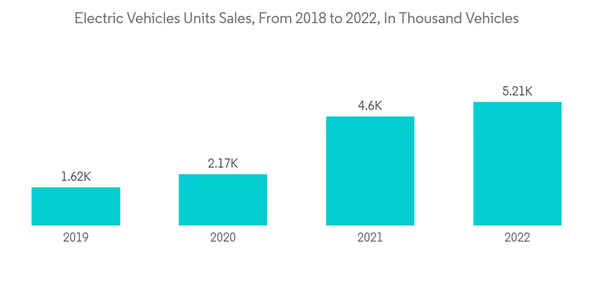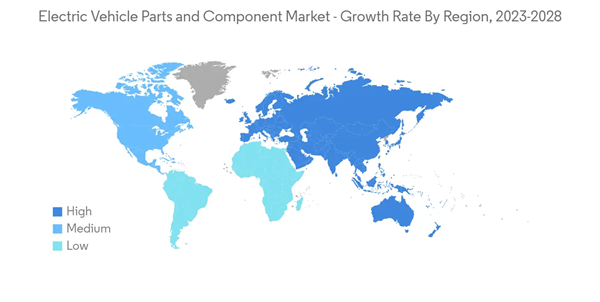The COVID-19 pandemic has affected almost every industry around the globe; despite the pandemic, the demand for electric vehicle parts and components has observed significant growth, owing to factors such as the rising demand and sales of electric vehicles.
Over the long term, the major factors driving the growth of the market studied are the enactment of stringent emission and fuel economy norms, government incentives, and improving charging infrastructure, which is leading to the increasing adoption of electric vehicles. This adoption of electric vehicles will propel the demand for electric motors during the forecast period. For instance,
Key Highlights
- January, 2023: DAF announced the construction of a new electric truck assembly factory in Eindhoven, where production of the new generation DAF XD and XF Electric will begin this spring. These zero-emission vehicles have a range of more than 500 kilometers.
The governments in various countries are spending heavily on electric mobility projects, which are going to provide an opportunity for electric vehicle component manufacturers, as governments are encouraging automobile manufacturers and customers to produce and adopt electric vehicles. The rise in the demand for electric vehicles is also expected to increase the sales of the components used in electric vehicles, such as motors, batteries, DC-DC converters, power inverters, etc. For instance,
Key Highlights
- January, 2023: PTT Synergy Group Berhad (PTTS) of Malaysia has signed a Memorandum of Understanding (MOU) with SANY International Developing (M) Sdn. Bhd. and Rootcloud Technology Singapore Pte. Ltd. (RC) to collaborate in a business that provides EV support and solutions through electric battery leasing services as well as the provision of renewable energy and zero carbon logistic instruments.
Moreover, post-pandemic the sales of EVs are also increasing, therefore, players are also focusing on the development of electric parts and components. For instance,
Key Highlights
- January, 2023: Sensata Technologies showcased its innovations that support vehicle electrification and a broad range of mission-critical sensors and electrical protection solutions for automotive and heavy vehicle off-road (HVOR) applications, at the Auto Expo Components 2023.
The Asia Pacific region is growing as a result of increased technological development, increased manufacturing and production of electric vehicles, increased integration of components in electric vehicles, and increased customer demand. Furthermore, increased government investment in continuous R&D in the market with advanced technologies in components and increased infrastructure development, which expands the market to a greater extent during the forecast period.
EV Parts & Components Market Trends
Increasing Investments in Electric Vehicles Driving the Market
Electric vehicles have become an integral part of the automotive industry, and it represents a pathway toward achieving energy efficiency, along with reduced emission of pollutants and other greenhouse gases. The increasing environmental concerns, coupled with favorable government initiatives, are the major factors driving this growth. The annual sales volume of electric passenger cars is projected to cross the 5 million mark by the end of 2025, and it is expected to account for 15% of the overall vehicle sales by the end of 2025. However, logistics and e-commerce are also investing heavily to increase their electric vehicle fleets. For example,- October, 2022: Amazon.com Inc will invest more than 1 billion euros (USD 974.8 million) in electric vans, trucks, and low-emission package hubs across Europe over the next five years, accelerating its drive to achieve net-zero carbon.
Several manufacturers have raised the bar to go beyond the previous announcements related to EVs with an outlook beyond 2025. More than ten of the largest OEMs have declared electrification targets for 2030 and beyond. Significantly, some OEMs plan to reconfigure their product lines to produce only electric vehicles. For instance,
- Mercedes-Benz is in the process of restructuring its strategy, to increase profits by focusing on higher-priced luxury vehicles. As part of its plan to go all-electric by 2030, the manufacturer intends to upgrade its product portfolio and discontinue lower-cost models.
- Volkswagen is planning to spend USD 36 billion on electric cars across its mass-market brands by 2024. According to the company, by 2025, at least 25% of its global sales will be electric vehicles.
- Mahindra & Mahindra (M&M) is one of the leading vehicle manufacturers in Asia. The company is planning to launch new electric vehicles. At present, the company has only one electric model, eVerito.
- Volvo announced that it will only sell electric cars from 2030. Ford will only sell electric cars in Europe from 2030. General Motors plans to offer only electric vehicles after 2035. Volkswagen aims for 70% electric car sales in Europe and 50% in China and the United States by 2030. Stellantis aims for 70% of the electric car sales in Europe and 35% in the United States.
Asia-Pacific Dominating the Market.
Rising government emphasis on increasing the adoption of electric vehicles and the availability of incentives from the government for electric vehicles are expected to drive the demand for electric vehicles during the forecast period. Governing bodies of several countries from Europe, North America, and Asia-Pacific have announced their plans to phase out fuel-powered vehicles during the upcoming 10 years. This will also have a positive impact on the growth of electric vehicles during the forecast period.Asia-Pacific is expected to grow at a faster rate, followed by Europe and North America, as countries such as China and Japan are inclined toward innovation, technology, and the development of advanced electric vehicles. Moreover, ASEAN countries are engaged in large electric mobility projects.
China is a key player in the global electric vehicle industry. Moreover, the government of China is encouraging people to adopt electric vehicles. The country is planning to completely switch to electric mobility by 2040. The Chinese electric passenger car market is also one of the largest worldwide, and it has been growing rapidly over the last few years and is expected to grow higher in the forecast period, which is also going to have a positive impact on the demand for electric vehicle parts and components market.
Japan has one of the best electric vehicle ecosystems in the world. Automotive companies like Toyota and Nissan are taking steps toward building electric vehicles in the country. The developments in the hybrid and electric vehicle market can be gauged by the presence of a number of players in the country. These favorable factors are expected to drive the market for hybrid and electric vehicles in Japan.
The Indian government has been formulating various strategies to reduce pollution in the country. For instance, the country, with its FAME and FAME II policies, has been providing incentives to customers and attractive options for investors as well as manufacturers to set up EV plants to propel the nation toward the faster adoption of green vehicles. Additionally, automobile manufacturers in India are also taking initiatives and investing in R&D practices to provide affordable electric cars in India; for instance,
- January, 2023: Tata AutoComp Systems Limited (Tata AutoComp) displayed a wide range of parts that it has already localized and is offering to the EV segment. Tata AutoComp has also been working on lightweight products and solutions to help electric vehicles extend their range.
EV Parts & Components Market Competitor Analysis
The key players in the global market include Denso Corporation, Robert Bosch GmbH, Continental AG, Contemporary Amperex Technology Co. Ltd., Panasonic Corporation, BorgWarner Inc, LG Chem Ltd., Hitachi Ltd., and others.The evolving partnerships between manufacturers and automotive companies are expected to expand the studied market globally. For instance,
- January, 2022: Volkswagen and Bosch signed a memorandum of understanding (MoU) in order to industrialize the production of battery cells. The companies intend to establish a project unit to investigate the feasibility of industrial-scale solutions for battery manufacturing in Europe. Both intend to provide integrated battery production systems, as well as on-site ramp-up and maintenance support for battery cell and system manufacturers, as well as the entire range of processes and components required for large-scale battery cell and system manufacturing.
Additional benefits of purchasing the report:
- The market estimate (ME) sheet in Excel format
- 3 months of analyst support
This product will be delivered within 2 business days.
Table of Contents
Companies Mentioned (Partial List)
A selection of companies mentioned in this report includes, but is not limited to:
- Continental AG
- Robert Bosch GmbH
- Denso Corporation
- Hella GmbH & Co. KGaA
- Toyota Industries Corporation
- Hyundai Mobis
- Samsung SDI Co Ltd
- Panasonic Corporation
- Contemporary Amperex Technology Co. Ltd.,
- BorgWarner Inc
- LG Chem Ltd.
- Hitachi Ltd










